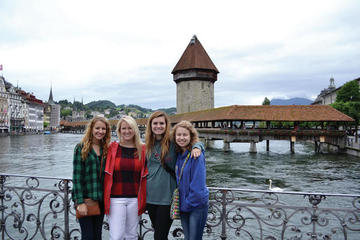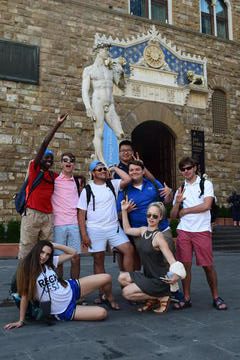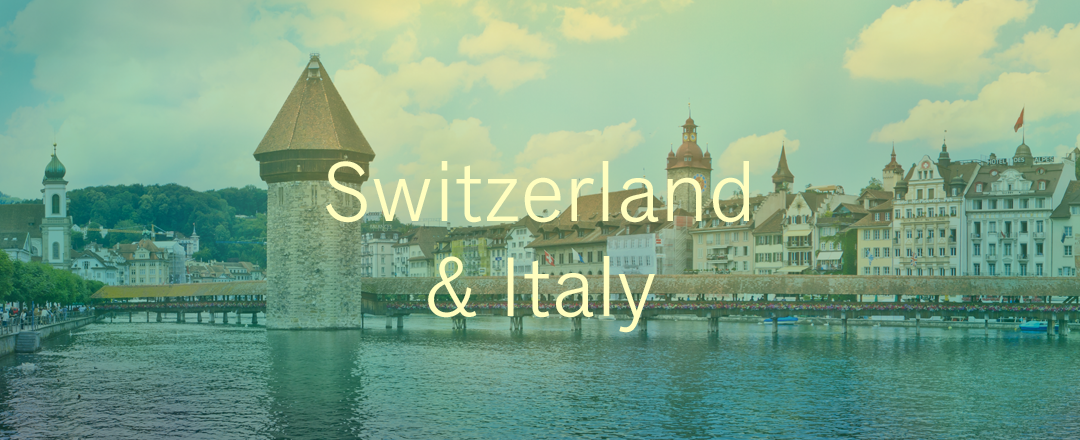Snow-capped mountains, meandering canals, artistic masterpieces and stunning works of architecture all await you in this comprehensive educational tour of Switzerland and Italy. If you’re looking to take your students on a jam-packed adventure through some of the countries’ most beautiful sites, this tour is for you.
Here’s an insider’s look at our brand new Switzerland & Italy tour:
Day 1: Travel
Day 2: Zurich, travel to Lucerne
Day 3: Lucerne
Your journey begins in beautiful Lucerne, Switzerland. Surrounded by snow-tipped mountains and bisected by the River Reuss, enjoy taking a walk through the gorgeous medieval town, founded all the way back in the ninth century.

The Kapellbrucke in Lucerne, Switzerland.
Your walking tour begins at Kapellbrucke. A 14th-century footbridge that runs over the Reuss, Kapellbrucke is a symbol of Lucerne. Get a glimpse of Lucerne’s history when you walk through the bridge: There, 17th-century paintings tell stories of the town.
The Löwendenkmal (Lion Monument) is your next stop. This somber sculpture, which is six meters high and was carved directly into the cliff face, depicts a lion dying from a spear wound, which you can see on its side. The monument commemorates the over 600 Swiss Guards who died defending the king in Tuileries Palace in Paris during the French Revolution in 1792.
Once you’ve explored the city, now it’s time to head up one of the mountains that make up the city’s backdrop. Ascend Mount Pilatus, the 6,982-foot tall peak, by cable car or by the world’s steepest cog railway, and see what Lucerne looks like from above. Also, if you believe in dragons, which you definitely should, look out for one — medieval legend has it that a dragon with healing powers lives on the mountain.
Finish off the day with fondue, a Swiss National Dish and a symbol of Swiss unity.
Day 4: Travel to Venice
Day 5: Venice

A canal in Venice, Italy.
From its gorgeous canals and bridges, to its stunning architecture, to its fascinating history, Venice is a traveler’s paradise. Start out in the heart of the city: St. Mark’s Square. Also called La Piazza, St. Mark’s is the main square of Venice, and is named for the city’s patron saint. As you walk through the square, note St. Mark’s Basilica dominating the scene, pigeons covering the ground, and shops and restaurants lining each side. Facing the basilica, check out a 15th-century clock tower to the left. To your right, you can’t miss the 300-foot, 16th-century bell tower known as St. Mark’s Campanile.
Finally, get a good look at the architectural highlight of Venice, St. Mark’s Basilica. Known as the site of St. Mark’s burial, this Byzantine-style basilica was originally built in the 11th century, and was nicknamed “Chieso d’Oro” (church of gold). Take a look at the mosaics depicting scenes from the life of Christ and the process of taking St. Mark’s body from Alexandria (in AD 828).
Connected to the basilica is Doge’s Palace, the residence of the doge (like a duke) of Venice. Don’t miss the Bridge of Sighs — the curved bridge connects the interrogation rooms of the Doge palace with the prison, and was considered a prisoner’s last glimpse of freedom before heading to his cell.
Finish off the day with a glass-blowing demonstration! The island of Murano off the coast of Venice is known for its glass industry, which had moved there by the 13th century. Glass was so important to the Venetian economy during this period that by the 14th century, glass makers had a special social status. The demonstration is a unique opportunity to get your students involved in Venetian history and culture.
Day 6: Verona
her eyes in heaven
Would through the airy region stream so bright
That birds would sing and think it were not night.
—Romeo and Juliet, Act 2, Scene 2
Shakespeare fans will love the next stop, the UNESCO World Heritage site of Verona, Italy. Famous for its medieval architecture, Verona is also well known for being the setting of two of Shakespeare’s plays, Romeo and Juliet and The Two Gentlemen of Verona. Head to the Casa de Giulietta, which features a bronze statue of Juliet. Then, see the Verona Arena, a Roman theater that was built in the first century and is still in use. At one time, it could hold 30,000 people, but now holds far fewer due to safety issues. The arena is now known for hosting operas.
Day 7: Florence
Take a train south to the seat of the Italian Renaissance, Florence! Another World Heritage Site, this red-roofed city was ruled by the powerful Medici family throughout its artistic peak. Start your tour at the Palazzo Vecchio, the Florence town hall, where a copy of Michelangelo’s David stands in the original’s place. The Palazzo overlooks Piazza della Signoria, a 14th-century plaza featuring plenty of beautiful sculptures. Nearby, the Ponte Vecchio bridge—dated as early as the 10th century—crosses the Arno river. Known for the many shops built along it, locals say the bridge was spared by the Germans during WWII on Hitler’s orders.

The replica of Michelangelo’s David in the Palazzo Vecchio in Florence, Italy.
Go southeast along the Arno to get to Chiesa di Santa Croce. The burial place of Michelangelo, Galileo, Machiavelli, and other famous Italians, this basilica includes 16 chapels.
You’ve probably already noticed the Duomo—actually called Cattedrale di Santa Maria del Fiore, this 13th-century Gothic style cathedral dominates Florence’s skyline. Featuring the world’s largest brick dome — completed in the 15th century — the cathedral has 436 steps to the top. Near the dome, you’ll see Giotto’s Bell Tower, a 14th-century tower with seven bells and featuring niches with statues by Donatello. Fun fact about the tower: The top three levels were completed after the bottom ones, and they were made larger so all of the levels appear the same size when you look up at the tower.
Your itinerary also includes the 11th-century Baptistery, which is famous for its three bronze doors with relief sculptures, and Dante’s House, the dwelling of the 13th-14th century poet, known for the Divine Comedy and for inventing terza rima. Stop by a leather workshop to learn about one of Florence’s prized industries.
Your day ends with one of the most popular tourist attractions in the world, the leaning tower of Pisa. Actually the bell tower behind the Pisa cathedral, it’s gained notoriety for its four-degree tilt, which has been a feature of the building since its 12th-century construction on too-soft ground. Spend a few moments walking the Campo dei Miracoli (Field of Miracles), a World Heritage Site.
Day 8: Rome
Make a brief stop at the St. Francis of Assisi Basilica before you head to Rome. This 13th-century basilica is a popular pilgrimage site, and is known as Francis’ birth and death place. It also holds the saint’s remains.
Next stop: Rome! Start off with a walking tour of Italy’s capital city, beginning with the Spanish Steps. Built in the 18th century, the 135-step stairway connects the Spanish embassy to the Holy See below. Then, take your spare change to the Trevi Fountain, one of the most famous fountains in the world. Also built in the 18th century, the massive fountain is a popular site for making a wish — an estimated $1.5 million was thrown in the fountain in 2016. Throw a coin with your right hand over your left shoulder.
If you wished to see one of the world’s greatest feats of architecture, you’re in luck: Your next stop is the world-famous Pantheon. First a Roman temple and now a church, the Pantheon was built in 126 AD and is still the world’s biggest concrete dome. View the massive columns and pediment before heading inside to take a look at the dome. Don’t forget to look up — the dome has hole in the center for sunlight. Just west of the Pantheon, you’ll head to the site of the 1st-century stadium Domitian, now a massive plaza.
Day 9: Rome
Start at the Vatican Museums, a collection of artistic masterpieces founded in the 16th century. Featuring several Raphaels and one da Vinci, this spellbinding museum will keep you moving from room to room in awe.

The Trevi Fountain in Rome.
Don’t forget to look up at the end, when you reach the Sistine Chapel. Painted by Michelangelo over a four-year period in the 16th century, the reluctant sculptor initially told Pope Julius II that he would rather not focus on painting. But the Pope wouldn’t budge, and Michelangelo painted the ceiling standing on a scaffolding with his head tilted back.
Exit the chapel directly to your next stop, the largest church in the world. St. Peter’s Basilica is well known as the burial site of Saint Peter. The sprawling church contains over 100 tombs, masterpieces of sculpture–including Michelangelo’s Pietà–and the world’s tallest dome, partially designed by Michelangelo himself.
Head to the city center to see the Colosseum, one of the world’s premier tourist attractions. The largest amphitheater ever built, it’s estimated that the Colosseum could once hold between 50,000 and 80,000 people, but it was designed so that it could be emptied in mere minutes. Once it was completed in AD 80, it was used for public spectacles, like gladiator fights and executions. It later fell into disrepair, being used at various times as a cemetery, housing units, and a fortress.
The largest collection of Roman ruins stands nearby, at the Forum Romanum, or Roman Forum. Once a marshland, the Roman Forum was the site of countless shrines, temples, political buildings, and statues of ancient Rome. Walk through the crumbling masterpieces and imagine what it looked like as the political center of Rome almost 2,000 years ago.
Then, head to a modern plaza, the Piazza Venezia, where many roads intersect and locals gather. Take a walk through the massive square — you can’t miss Il Vittoriano, the monument to the first king of Italy.
Day 10: End tour
Take an optional extension to Sorrento for a visit to Pompeii and the Blue Grotto. Read the full itinerary.

